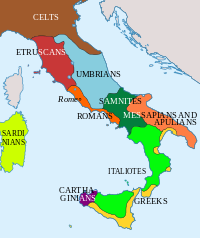| History of Italy |
|---|
 |
|
|


The Italiotes (Greek: Ἰταλιῶται, Italiōtai) were the pre-Roman Greek-speaking inhabitants of the Italian Peninsula, between Naples and Calabria.[citation needed]
Greek colonisation of the coastal areas of southern Italy and Sicily started in the 8th century BC and, by the time of the Roman ascendance, the area was so extensively hellenized that Romans called it Magna Graecia, that is "Greater Greece".
The Latin alphabet is a derivative of the Western Greek alphabet used by these settlers, and was picked up and adopted and modified first by the Etruscans and then by the Romans.[citation needed]
See also
[edit]- Italiote league
- Ancient peoples of Italy
- Battle of Pandosia
- Greek coinage of Italy and Sicily
- Italiot Greek: modern dialects
- Magna Graecia
- Milo of Croton
- Phlyax play
- Siceliotes
- Sicels
Notes
[edit]References
[edit]- A history of earliest Italy By Massimo Pallottino, 15 April 1991, Page 118 ISBN 0-472-10097-1
- The Cambridge ancient history By John Boardman Page 709 ISBN 0-521-85073-8
- Rome and the Western Greeks, 350 BC-AD 200 Page 103 ISBN 0-415-05022-7
- Gender and ethnicity in ancient Italy By Tim Cornell, Kathryn Lomas Page 40 ISBN 1-873415-14-1
- Calabria, the first Italy By Gertrude Elizabeth Taylor Slaughter Page 107
Well, that’s interesting to know that Psilotum nudum are known as whisk ferns. Psilotum nudum is the commoner species of the two. While the P. flaccidum is a rare species and is found in the tropical islands. Both the species are usually epiphytic in habit and grow upon tree ferns. These species may also be terrestrial and grow in humus or in the crevices of the rocks.
View the detailed Guide of Psilotum nudum: Detailed Study Of Psilotum Nudum (Whisk Fern), Classification, Anatomy, Reproduction